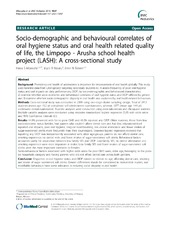| dc.description.abstract | Background Promoting oral health of adolescents is important for improvement of oral health globally. This study used baseline-data from LASH-project targeting secondary students to; 1) assess frequency of poor oral hygiene status and oral impacts on daily performances, OIDP, by socio-demographic and behavioural characteristics, 2) examine whether socio-economic and behavioural correlates of oral hygiene status and OIDP differed by gender and 3) examine whether socio-demographic disparity in oral health was explained by oral health-related behaviours. Methods Cross-sectional study was conducted in 2009 using one-stage cluster sampling design. Total of 2412 students (mean age 15.2 yr) completed self-administered questionnaires, whereas 1077 (mean age 14.9 yr) underwent dental-examination. Bivariate analyses were conducted using cross-tabulations and chi-square statistics. Multiple variable analyses were conducted using stepwise standardized logistic regression (SLR) with odds ratios and 95% Confidence intervals (CI). Results 44.8% presented with fair to poor OHIS and 48.2% reported any OIDP. Older students, those from low socio-economic status families, had parents who couldn't afford dental care and had low educational-level reported oral impacts, poor oral hygiene, irregular toothbrushing, less dental attendance and fewer intakes of sugar-sweetened drinks more frequently than their counterparts. Stepwise logistic regression revealed that reporting any OIDP was independently associated with; older age-groups, parents do not afford dental care, smoking experience, no dental visits and fewer intakes of sugar-sweetened soft drinks. Behavioural factors accounted partly for association between low family SES and OIDP. Low family SES, no dental attendance and smoking experience were most important in males. Low family SES and fewer intakes of sugar-sweetened soft drinks were the most important correlates in females. Socio-behavioural factors associated with higher odds ratios for poor OHIS were; older age, belonging to the poorest household category and having parents who did not afford dental care across both genders. Conclusion Disparities in oral hygiene status and OIDP existed in relation to age, affording dental care, smoking and intake of sugar sweetened soft drinks. Gender differences should be considered in intervention studies, and modifiable behaviours have some relevance in reducing social disparity in oral health. | en_US |

